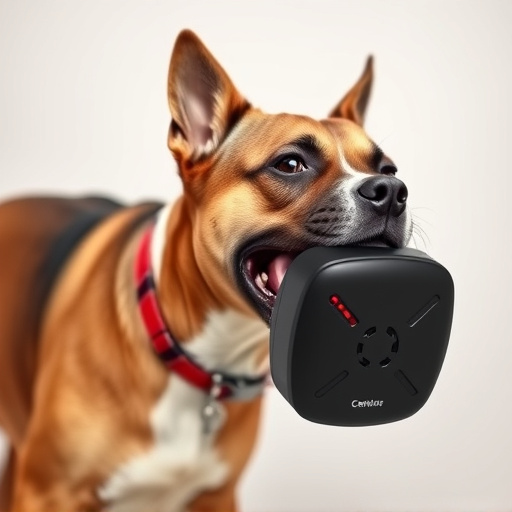Mounting options for electronic dog deterrents are vital for maximizing their effectiveness. These devices, using sounds, vibrations, and shock, aim to humanely stop excessive barking. They can be attached to collars for targeted training or mounted on posts/walls near problematic areas for distance-based deterrence in larger spaces. Handheld devices with GPS tracking and remote control features offer flexible mounting options like clips, suction cups, car mounts, or pet collar attachments. The right mounting choice depends on the setting: wall-mounted for large areas, handheld for smaller spaces. Proper training, safety, and personalized guidance are essential when using these deterrents.
“Discover the revolutionary power of electronic handheld devices for bark prevention—a non-lethal, effective solution for canine behavior management. This comprehensive guide explores how these innovative tools work, shedding light on their growing popularity in the pet care industry. From understanding the technology to selecting the right device and mounting options, we’ll navigate you through every step. Learn essential safety precautions and training tips to ensure successful integration into your dog’s life.”
- Understanding Electronic Dog Deterrents: How They Work
- Types of Handheld Devices and Their Features
- Mounting Options: Choosing the Right Fit for Your Needs
- Safety Precautions and Training Tips for Effective Use
Understanding Electronic Dog Deterrents: How They Work
Electronic dog deterrents, also known as bark prevention devices, are innovative tools designed to address excessive barking issues in a humane and effective manner. These devices work by emitting specific sounds or vibrations that capture a dog’s attention, prompting them to stop barking. The technology is based on positive reinforcement; when the dog ceases barking, the device shuts off, reinforcing the desired behavior.
Mounting options play a crucial role in the effectiveness of these deterrents. Devices can be attached to collars or posts, offering flexibility in placement depending on the user’s preferences and the dog’s behavior patterns. For instance, collar-mounted deterrents are convenient for training purposes, allowing owners to target specific barking instances. Alternatively, mounting the device on a post or wall near problematic areas can help deter barking from a distance, which is ideal for larger yards or public spaces.
Types of Handheld Devices and Their Features
Handheld devices designed for bark prevention often come in various forms, each with unique features catering to different preferences and needs. Some models employ ultrasonic sound technology, emitting high-frequency waves that are inaudible to humans but irritant to dogs, effectively deterring excessive barking. Others use vibration or subtle electric shocks as a warning mechanism, offering a more physical approach to training. Advanced devices may even incorporate GPS tracking and remote control features, allowing users to monitor and manage their pets from afar.
Mounting options for these electronic dog deterrents play a significant role in their effectiveness and usability. Many devices offer flexible mounting solutions, such as adjustable clips or suction cups, enabling users to attach them to various surfaces like fences, trees, or even pet collars. Some models are designed for handheld use, perfect for immediate interventions during bark episodes, while others come with car mounts, allowing drivers to keep an eye on their pets and prevent unwanted barking while on the road.
Mounting Options: Choosing the Right Fit for Your Needs
When it comes to Mounting Options for Electronic Dog Deterrent devices, there’s a variety of choices available that cater to different needs and preferences. Many modern handheld devices offer flexible mounting solutions, allowing users to attach them conveniently to various surfaces. Some popular options include attaching the device to your dog’s collar, fixing it on a wall within reach, or even integrating it into your car’s interior for in-motion deterrence.
Each mounting option provides unique benefits tailored to specific scenarios. For instance, securing the device on your dog’s collar is ideal for outdoor activities as it keeps the unit handy and responsive. Wall mounts are practical for indoor use, ensuring easy access while training or managing unwanted behaviors. Car mounts, on the other hand, offer a game-changing solution for pet owners who travel frequently with their dogs, providing consistent deterrence during journeys.
Safety Precautions and Training Tips for Effective Use
When using an electronic dog deterrent, or bark prevention device, it’s crucial to prioritize safety and proper training for both you and your pet. Always refer to the manufacturer’s guidelines and consult a professional trainer or veterinarian for personalized advice. Choose mounting options suitable for your living space; wall-mounted devices can be effective in larger areas, while handheld models offer flexibility for smaller, more confined spaces. Training should start with understanding your dog’s triggers—what specifically makes them bark excessively. Use the device as a last resort when other methods have been exhausted, and always set it to a low level initially, gradually increasing as needed. Regular practice sessions will help desensitize your pet to the sound, ensuring its effectiveness over time.
During training, keep sessions short and positive, rewarding calm behavior with treats or praise. Consistency is key; use the device at consistent times and in specific situations to teach your dog the desired behavior. Never punish your pet for barking during training—this can create fear or anxiety. Instead, focus on positive reinforcement techniques that encourage quiet, calm demeanor. Regularly review and adjust settings as your dog becomes more accustomed to the device, ensuring it remains effective without causing discomfort or stress.
Electronic handheld devices for bark prevention offer a humane and effective solution to managing excessive dog barking. By understanding how these devices work, choosing the right type with suitable mounting options, and following safety precautions, you can train your pet while maintaining a peaceful environment for everyone. Remember, consistent use and positive reinforcement are key to success when employing an electronic dog deterrent.
